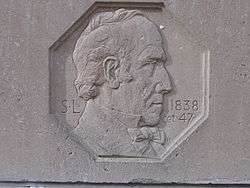Mackenzie House
|
| |
| Established | 1936 |
|---|---|
| Location | 82 Bond Street, Toronto, Ontario Canada |
| Type | Municipal Museum |
| Website | Mackenzie House |
Mackenzie House is a historic building and museum in Toronto, Canada that was the last home of William Lyon Mackenzie, the city's first mayor. It is now a museum operated by the City of Toronto's Museum and Heritage Services.[1]
Mackenzie's first home in Toronto was on York Street south of Queen. It was built in 1830 by Major Andrew Patton, formerly of the 45th regiment and barrack master of York Garrison, where he lived until his death in 1835. In 1835 Mackenzie leased the property and lived there until 1837, when he sold the lease. The advertisement for the lease appeared in the January 11, 1837 issue of his newspaper, The Constitution. After Mackenzie's failed rebellion this house was taken by the government and occupied by Colonel Hill and then Colonel Bagot.[2]
Mackenzie was forced into exile in the United States after having led the Rebellion of 1837. He returned to the newly created Province of Canada in 1850, after being the last rebel pardoned. Mackenzie returned to Canada in dire financial states. The house at 82 Bond Street was bought for Mackenzie by his friends and supporters in 1858. He died in the house in 1861; His wife and three daughters stayed in the house for another ten years.
The neighbouring row houses were demolished in 1936, while Mackenzie's grandson, William Lyon Mackenzie King, was Prime Minister. However, this house was saved because of its historical significance. Designed in the Georgian architecture style, today the house serves as a municipally run historic house museum about 1860s Urban Victorian life.
Museum operation
Mackenzie House is one of ten historic museums owned and operated by the City of Toronto. Its visitor experience focuses on the life and times of the Mackenzie family as well as Mackenzie's role as a newspaper editor and politician. The museum also depicts life in the fast growing and diverse Toronto of the 1860s to the 1890s, including programs focused on Black Canadians and Mary Ann Shadd .
Memorial Arch
An interesting addition to the grounds are the side panels of the Memorial Arch that once stood at the foot of the Honeymoon Bridge in Niagara Falls, Ontario.[3] Built in 1930s, the arch was demolished in 1960s and the panels stored until it was moved to Toronto in 1974. It is installed in an area next to the historic home.
-

Emanuel Hahn's "Mackenzie Panels" (1938) in the garden of Mackenzie House. The panel shows William Lyon Mackenzie presenting his historic Seventh Report of Grievances to the House of Assembly of Upper Canada.
-

Emanuel Hahn's Memorial to Samuel Lount at Mackenzie House. Names of those executed during the repression that followed defeat of the rebellion appear on one of the panels, as do profiles of the two rebels who met their death on the scaffold in Toronto, Samuel Lount and Peter Matthews.
Affiliations
The Museum is affiliated with: CMA, CHIN, and Virtual Museum of Canada.
References
- ↑ {url= http://www1.toronto.ca/wps/portal/contentonly?vgnextoid=512d2271635af310VgnVCM10000071d60f89RCRD
- ↑ Peppiatt, Liam. "Chapter 60: Mackenzie's York Street Home". Robertson's Landmarks of Toronto Revisited.
- ↑ http://spacingtoronto.ca/2008/02/08/remnants-of-niagaras-arc-de-triomphe/
- Mackenzie House
- Cruikshank, Tom. Old Toronto Houses. Toronto: Firefly Books, 2003.
See also
| Wikimedia Commons has media related to Mackenzie House. |
Coordinates: 43°39′20″N 79°22′42″W / 43.655665°N 79.378291°W